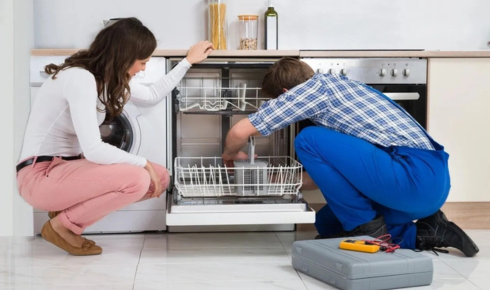There’s nothing quite like opening your refrigerator expecting a burst of cool air — only to be hit with lukewarm disappointment. You check again, thinking maybe it’s your imagination, but no… the milk isn’t cold, the veggies feel soft, and the fridge has clearly gone rogue. Then you check the freezer, and surprise — everything’s frosty, solid, and just as it should be.
It’s one of those strange domestic mysteries that can ruin your morning coffee and make you question all of life’s little mechanics. If you’re staring at a freezer cold fridge warm situation, don’t panic yet. You’re not alone — and this problem, though irritating, is surprisingly common.
The Two-in-One System We Rely On
Most people think the fridge and freezer operate independently — like two separate machines stacked together. But in reality, they share one cooling system. The freezer does most of the heavy lifting, generating cold air, which is then pushed into the refrigerator section through vents and fans.
When that airflow is disrupted, you end up with this strange imbalance: frozen food that could outlast a zombie apocalypse and a fridge that feels like a sauna. It’s not that your appliance stopped cooling entirely; it’s just that the cold air isn’t being distributed properly.
The tricky part is figuring out why.
Start with the Obvious (Because Sometimes It Really Is That Simple)
Before you start imagining expensive repairs, check the basics.
First: is your fridge overstuffed? It sounds harmless, but overcrowding blocks air vents and prevents circulation. That cold air from the freezer can’t reach the fridge compartment if every shelf is packed tight with leftovers and soda bottles. Try rearranging things or even running it a bit emptier for a day or two to see if temperatures balance out.
Also, make sure the vents between the freezer and fridge aren’t covered by frozen pizza boxes or stacked containers. These vents are the cold air’s lifeline — when they’re blocked, even the best compressor can’t help.
Check the Fans — They’re the Unsung Heroes
If the airflow looks fine but the problem persists, listen closely. When you open the freezer, do you hear a soft whirring sound? That’s the evaporator fan — the small but mighty part responsible for moving cold air into both compartments.
If it’s not spinning, that could easily explain your uneven temperatures. Sometimes, frost buildup can block the blades; other times, the motor itself just gives up. You can check for frost by removing the freezer’s back panel (unplug the fridge first, of course). A thick sheet of ice back there means it’s time for a defrost cycle or some manual intervention.
The good news is that if the fan’s the issue, it’s one of the easier and cheaper components to replace.
The Case of the Over-Frozen Coils
Another sneaky cause is frozen evaporator coils. These are the metal tubes behind the freezer wall that absorb heat from inside the fridge. When they get coated in frost, they can’t do their job properly, so the cold air never reaches the refrigerator compartment.
Most modern fridges have an automatic defrost system, but if that fails, frost builds up silently until you’re stuck wondering why the freezer is icy perfection while the fridge side feels like early spring.
Unplug the fridge for 24 hours to let it thaw completely. Place towels around it — it’s messy but effective. Once everything melts, plug it back in and see if the cooling returns. If it does, the defrost heater or timer likely needs replacing to prevent the issue from coming back.
When the Freezer Works but the Fridge Refuses
Sometimes, no amount of defrosting or rearranging helps. You’ve cleaned, checked vents, maybe even whispered encouraging words — and still, nothing changes. That’s when you might be dealing with a more technical problem, something that falls under the dreaded refrigerator not working but freezer is category.
This can point to a malfunctioning damper control assembly. The damper is like a gate that controls how much cold air flows into the fridge. If it’s stuck closed — due to ice, a broken motor, or just wear and tear — your freezer will thrive while your fridge languishes.
Another potential culprit is the temperature sensor (thermistor). When it misreads the fridge’s temperature, it fails to trigger cooling at the right time. Replacing it is usually inexpensive and often the difference between a fridge that sighs back to life and one that keeps pretending to be a pantry.
For Whirlpool Owners — A Common Quirk
If you happen to own a Whirlpool side-by-side refrigerator, this uneven cooling issue can feel even more familiar. It’s practically a rite of passage for some models.
When you notice your whirlpool side by side not cooling, don’t rush to blame the compressor. In many cases, the culprit is the diffuser or air damper again. These Whirlpool units rely heavily on that mechanism to channel air evenly, and when it fails, the temperature difference between the two sides can be dramatic.
Another Whirlpool-specific problem? The adaptive defrost control board. It’s the little circuit brain that tells your fridge when to defrost. If it glitches, the coils freeze solid, leading to a warm fridge — no matter how many times you adjust the temperature setting.
A Dirty Secret: The Coils Below
We often ignore the space beneath our refrigerator. But those coils under there — the condenser coils — are vital for keeping things cool. Over time, they get covered in dust, lint, and sometimes pet hair, acting like a blanket that traps heat.
When that happens, your fridge has to work overtime to keep the freezer cold, and it often gives up on the fridge entirely. A simple cleaning with a coil brush or vacuum can restore efficiency and balance temperatures again. It’s the kind of fix that feels too easy, but you’ll be amazed at how often it works.
When to Wave the White Flag
If you’ve tried all the above — cleared vents, defrosted coils, cleaned the condenser, and checked fans — and your fridge is still acting stubborn, it’s time to call in a professional. Refrigeration systems rely on pressurized refrigerant and sealed components, so there’s only so much a homeowner can safely do.
A technician can check the compressor’s performance, test the control board, and inspect refrigerant levels. The fix might be as simple as a faulty relay switch or as complex as a sealed system repair. Either way, catching the problem early usually saves money (and groceries).
Preventing Future Fridge Drama
Like most household heroes, your refrigerator appreciates a little attention now and then. Keep it happy with these simple habits:
- Clean the coils every six months.
- Avoid overpacking shelves — airflow matters.
- Check the door seals for leaks (a piece of paper should hold snugly when closed).
- Don’t set the temperature too low — it strains the system unnecessarily.
These little things help extend your fridge’s life and prevent those “warm fridge, cold freezer” mysteries from returning.
A Thought to Leave You With
A malfunctioning fridge always feels urgent — it’s the kind of problem that forces you to act fast before your food spoils. But the fix isn’t always as complicated as it looks. Most of the time, it’s about airflow, frost, or a small part doing a big job.
So the next time you’re puzzled by uneven cooling, take a breath. Observe, clean, troubleshoot, and give your appliance a fair shot at redemption. Because chances are, your fridge isn’t failing you — it just needs a little help finding its balance again.

